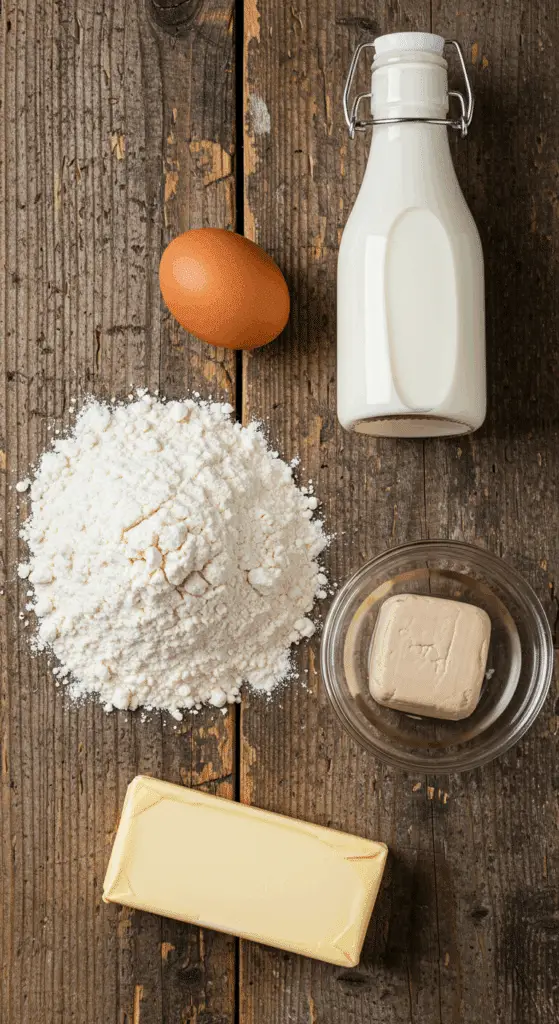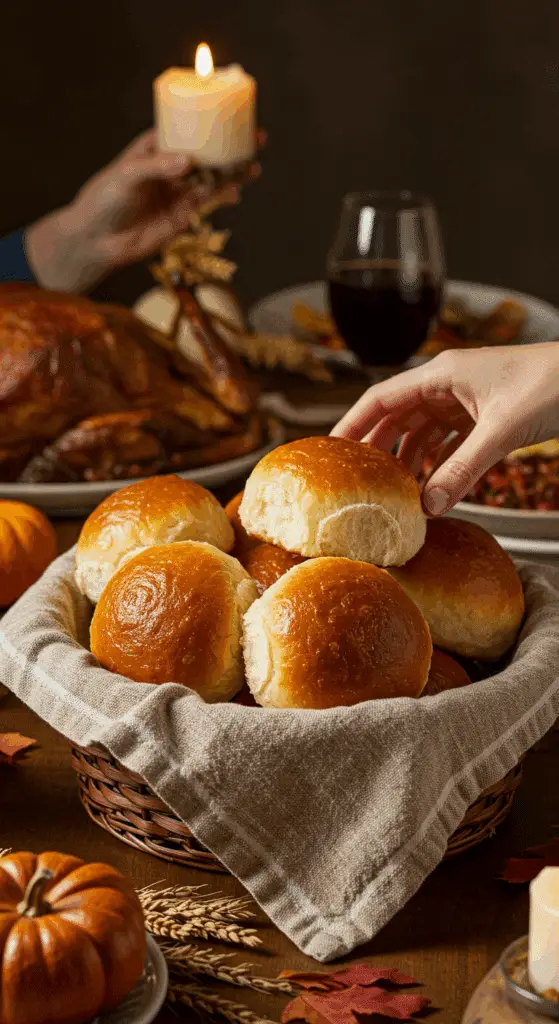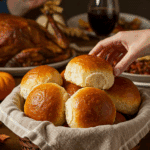Are you ready to bake the most legendary, most buttery, and most pillowy-soft dinner rolls of your life? It’s time to master the classic, historic, and utterly irresistible Parker House Roll. These aren’t just any dinner rolls; they are a true American institution, famous for their uniquely soft and rich texture, their subtle sweetness, and their iconic, folded “pocketbook” shape.
This is your ultimate guide to creating these stunning, from-scratch yeast rolls at home. We’ll walk you through the simple, time-honored techniques for creating a beautiful, enriched dough, and we’ll show you the secret to shaping them into their classic form. Get ready to fill your home with the incredible aroma of fresh-baked bread and create a new holiday tradition that your family will request for years to come.
Table of Contents
Table of Contents
Recipe Overview: The Ultimate Holiday Dinner Roll
What makes Parker House Rolls a timeless classic is their incredibly soft, rich, and tender texture, which comes from an “enriched” yeast dough. Unlike lean, crusty breads, an enriched dough contains ingredients like milk, butter, sugar, and eggs, which result in a wonderfully soft crumb and a rich flavor. This recipe will guide you through the simple, rewarding process of kneading, rising, and shaping to create the most impressive and delicious dinner rolls you’ve ever had. They are the absolute perfect addition to any special occasion, especially a Thanksgiving or Christmas feast.
| Metric | Time / Level |
| Total Time | 2 hours 45 minutes |
| Active Prep Time | 20 minutes |
| Difficulty Level | Intermediate |
| Servings | 24-30 rolls |
The Essential Ingredients for a Perfect Roll
This recipe uses a handful of simple pantry staples to create a truly spectacular, enriched dough.
- The Enriched Dough: This is what gives the rolls their signature soft texture and rich flavor.
- Milk, Butter, and Sugar: We start by gently heating the milk (a technique called scalding) and melting in the butter and sugar. This combination creates a tender, soft crumb and a subtle sweetness.
- Eggs: An egg adds richness, flavor, and a beautiful golden color to the dough.
- The Leavener (Active Dry Yeast): We use active dry yeast, which needs to be “bloomed” or activated in warm water first. This simple step ensures your yeast is alive and ready to work its magic, giving your rolls a beautiful, airy rise.
- All-Purpose Flour: The structural foundation of our rolls. All-purpose flour has the perfect amount of protein to create a dough that is both strong enough to hold its shape and tender enough for a soft, fluffy roll.
- The Finishing Touch (Melted Butter): A final, generous brush of melted butter after the rolls come out of the oven is non-negotiable! It gives them a beautiful, shiny finish and a final layer of incredible, buttery flavor.

Step-by-Step to Perfect Parker House Rolls
Making yeast dough is a fun and rewarding process. Follow these detailed steps for a perfect, fluffy result every time.
Step 1: Prepare the Enriched Dough
Step 1: In a small saucepan, place the 1 1/2 cups of milk and bring it to a simmer over medium heat. As soon as you see bubbles forming around the edges, remove it from the heat. Stir in the 1 stick of butter and the 1/2 cup of sugar until they are melted and dissolved. Let this mixture cool until it is just lukewarm.
Step 2: While the milk mixture is cooling, activate your yeast. In a small bowl, dissolve the 1 package of active dry yeast in the 1/2 cup of warm water (it should feel like a warm bath, about 110°F). Let it sit for about 5-10 minutes, until the mixture becomes foamy and fragrant. This “blooming” process proves your yeast is active.
Step 3: In the bowl of a stand mixer fitted with the dough hook attachment, combine the cooled milk mixture, the lightly beaten eggs, the foamy yeast mixture, the 1 1/2 teaspoons of salt, and half of the flour (3 cups). Mix on low speed until the ingredients are smooth.
Step 4: Continue to mix on low speed while adding the remaining 3 cups of flour, about 1/2 cup at a time, until a soft, smooth ball of dough forms that pulls away from the sides of the bowl.
Step 2: Knead and the First Rise (Developing Flavor)
Step 1: Turn the dough out onto a lightly floured surface. Knead the dough by hand for about 5 minutes, until it is smooth and elastic.
Step 2: Place the dough in a large, lightly greased bowl. Cover the bowl with plastic wrap or a clean kitchen towel.
Step 3: Let the dough rise in a warm, draft-free place until it has doubled in size, which will take about 60 to 70 minutes.
Step 3: How to Shape the Classic Parker House Rolls
Step 1: Gently punch down the risen dough to release the air. On a lightly floured surface, roll the dough out to about a 1/2-inch thickness.
Step 2: Use a 2 1/2 to 3-inch round biscuit cutter to cut out as many circles of dough as you can.
Step 3: Now for the classic fold! Brush the surface of each dough circle with a little melted butter. Use the dull side of a butter knife or a thin chopstick to press a crease just off-center in each circle.
Step 4: Fold the larger side of the dough circle over the smaller side, creating the iconic “pocketbook” or folded shape.
Step 5: Place the shaped rolls, about an inch apart, on a large baking sheet that has been lined with parchment paper.
Step 4: The Second Rise (Creating the Fluffiness)
Cover the baking sheet loosely with plastic wrap and let the shaped rolls rise in a warm place for a final time, until they have doubled in size and look puffy, about 30 to 40 minutes.
While the rolls are rising, preheat your oven to 350°F (175°C).
Step 5: Bake to Golden Perfection
Bake the risen rolls for about 20 minutes, or until they are a beautiful, even golden brown on top.
As soon as you remove the rolls from the oven, use a pastry brush to brush the tops generously with more melted butter. This gives them a beautiful shine and a final, irresistible layer of buttery flavor.
Serve the rolls warm.

The Best Classic & Fluffy Parker House Rolls Recipe
A classic recipe for Parker House Rolls, a type of soft, buttery, and slightly sweet dinner roll. The enriched dough is made with milk, butter, sugar, and eggs, and is prepared using a stand mixer. The dough goes through two separate rising periods to develop a light and fluffy texture. After being shaped and baked until golden brown, the hot rolls are brushed with more melted butter for a rich finish.
- Prep Time: 2 hours 10 minutes (includes rising times)
- Cook Time: 20 minutes
- Total Time: 2 hours 30 minutes
- Yield: 24-30 rolls
- Category: Bread
- Method: Baking
- Cuisine: American
- Diet: Vegetarian
Ingredients
- 1 1/2 cups milk
- 1 stick (8 tablespoons) unsalted butter, cut into pieces, plus more for brushing
- 1/2 cup sugar
- 1 package active dry yeast
- 1/2 cup warm water
- 3 large eggs, lightly beaten
- 1 1/2 teaspoons salt
- 6 cups all-purpose flour
Instructions
- In a small saucepan, bring the milk to a simmer. Remove from the heat and stir in the butter pieces and sugar until melted and dissolved. Let the mixture cool to lukewarm.
- In a small bowl, dissolve the yeast in the warm water and let it sit for about 5 minutes, until it becomes foamy.
- In the bowl of a stand mixer fitted with a dough hook, combine the cooled milk mixture, beaten eggs, yeast mixture, salt, and half of the flour (3 cups). Mix until smooth.
- Add the remaining flour, 1/2 cup at a time, and continue to mix until a smooth ball of dough forms.
- Turn the dough out onto a floured surface and knead by hand for about 5 minutes.
- Place the dough in a greased bowl, cover it, and let it rise in a warm place for 60 to 70 minutes, or until doubled in bulk.
- On a floured surface, punch down the dough. Shape the dough into your desired roll shapes and place them on a parchment paper-lined baking sheet.
- Cover the rolls again and let them rise for another 30 to 40 minutes, until doubled in size.
- Preheat the oven to 350°F.
- Bake the rolls for about 20 minutes, or until golden brown.
- Remove the rolls from the oven and brush them with melted butter before serving.
Notes
- This recipe uses a two-stage rising process, which is essential for developing the light, airy texture of the yeast rolls.
- A stand mixer with a dough hook is the recommended tool for making the dough, but it can also be mixed and kneaded by hand.
- Brushing the hot, freshly baked rolls with melted butter adds extra richness and a soft crust.
Storage and Make-Ahead Tips
These Parker House Rolls are a fantastic make-ahead option for a big holiday meal.
- Storing Baked Rolls: The baked rolls are at their best on the day they are made. However, you can store them in an airtight bag or container at room temperature for up to 3 days.
- Reheating: To bring back that fresh-from-the-oven softness, you can re-warm the rolls, wrapped in foil, in a 350°F oven for about 5-10 minutes.
- Freezing Baked Rolls: Let the baked rolls cool completely, then place them in a freezer-safe bag. They will keep in the freezer for up to 3 months. Thaw at room temperature and re-warm as directed above.
- Freezing the Dough: You can freeze the dough after the first rise. Punch it down, wrap it tightly in plastic wrap and then place it in a freezer bag. It will keep for up to a month. Thaw it overnight in the refrigerator, then proceed with the shaping and the second rise.
For more recipe follow my Pinterest account
Creative Recipe Variations
This classic, enriched dough is a wonderful base for your own delicious and creative twists.
- Classic Herbed Parker House Rolls: For a wonderful, savory roll that is perfect with any meal, you can add 2 to 3 tablespoons of finely chopped fresh herbs to the dough along with the flour. A combination of rosemary, thyme, and chives is fantastic.
- Savory Garlic-Parmesan Rolls: For an irresistible, cheesy version, you can brush the hot, freshly baked rolls with a garlic-infused melted butter (simply melt the butter with one crushed garlic clove) and then immediately sprinkle them with a generous amount of grated Parmesan cheese.
- Sweet Honey-Butter Rolls: For a slightly sweeter roll that is perfect for serving with a holiday ham, you can make a simple honey-butter glaze. Simply whisk together 4 tablespoons of melted butter with 2 tablespoons of honey and brush this over the hot, baked rolls.
Enjoy a True American Classic!
You’ve just created a truly special, from-scratch bake that is a treasured piece of American culinary history. These Classic Parker House Rolls, with their impossibly soft, pillowy texture and their rich, buttery flavor, are guaranteed to be the most requested and beloved bread on your holiday table. They are a rewarding and deeply satisfying project that proves the magic of simple, classic baking.
We hope you and your loved ones enjoy every last, perfect, buttery bite!
If you enjoyed making this recipe, please leave a comment below or share it with a friend who loves to bake!
Frequently Asked Questions (FAQs)
Q1: What are Parker House Rolls, and where did they come from?
Parker House Rolls are a famous American dinner roll that originated in the 1870s at the Parker House Hotel in Boston, Massachusetts. They are known for their rich, enriched dough, their subtle sweetness, and their signature folded “pocketbook” shape, which is created by folding a buttered circle of dough in half before the final rise.
Q2: Why did my yeast dough not rise?
There are two common culprits for a dough that doesn’t rise. First, your yeast may have been old or expired. The “blooming” step (dissolving the yeast in warm water) is a great way to test it; if it doesn’t get foamy after 10 minutes, your yeast is likely no longer active. Second, the liquid you added it to may have been too hot or too cold. The yeast needs warm water (about 110°F) to activate. Water that is too hot will kill the yeast.
Q3: Can I make these rolls without a stand mixer?
Yes, you absolutely can! A stand mixer just makes the initial mixing and kneading process a bit easier. To make them by hand, simply mix all the ingredients together in a large bowl with a wooden spoon until a shaggy dough forms. Then, turn the dough out onto a floured surface and knead it by hand for about 8 to 10 minutes, until it is smooth and elastic.
Q4: What is the secret to their incredibly soft texture?
The secret is that this is an enriched dough. The addition of fats and tenderizers like milk, butter, and eggs is what creates a much softer, more tender, and richer crumb than you would find in a “lean” dough (like a crusty French baguette), which is typically made from just flour, water, salt, and yeast.
Q5: What does “scalding” the milk mean, and why is it done?
Scalding is the old-fashioned technique of heating milk to just below the boiling point. While it’s not as crucial with modern pasteurized milk, it was traditionally done to kill any bacteria. In baking, it also serves a purpose: it denatures a specific whey protein in the milk that can sometimes interfere with gluten development, which can result in an even softer, higher-rising final product.


